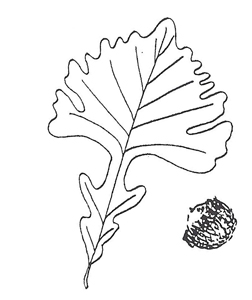Quercus macrocarpa (kware’-kus mak-ro-kar’-pa)
Family: Fagaceae, Beech
Key Steps
- 1b – Alternate leaf arrangement — go to 18
- 18a – Leaf simple — go to 19
- 19b – Thornless — go to 22
- 22d – All leaves lobed — go to 23
- 19b – Thornless — go to 22
- 18a – Leaf simple — go to 19
Description
 Leaf: Lobes rounded, no bristle tip. Leaf usually narrow from base to the middle, then has a deeply indented sinus, and the rest of leaf widens out with rest of sinuses not being as deep as the one in the the center of leaf. Leaf hairy, whitish beneath. Dull, medium-green above.
Leaf: Lobes rounded, no bristle tip. Leaf usually narrow from base to the middle, then has a deeply indented sinus, and the rest of leaf widens out with rest of sinuses not being as deep as the one in the the center of leaf. Leaf hairy, whitish beneath. Dull, medium-green above.
Bud: Scale overlap. 10+ scales. Gray to yellowish-brown. Terminal bud under 3/16 inch long, rounded.
Leaf Scar: Raised, half round. 12 or more bundle scars. (If you can’t find bundle scars in one leaf scar, look at some of the other leaf scars and other branches.)
Stem: Yellow-brown. May be hairy and have corky wings.
Bark: Dark gray. Older branches may be corky.
Pith: Solid, 5-angled or star-shaped. Pale brown.
Flower: Male catkins at base of new growth, yellow-green.
Fruit: Acorn. Cap covers at least 1/2 of acorn and has mossy fringe. Inside cap is hairless.
Habit: Oval to broad when mature. 40+ feet tall.
Culture: Full sun. Adapts to alkaline soils and drought.
Resources




